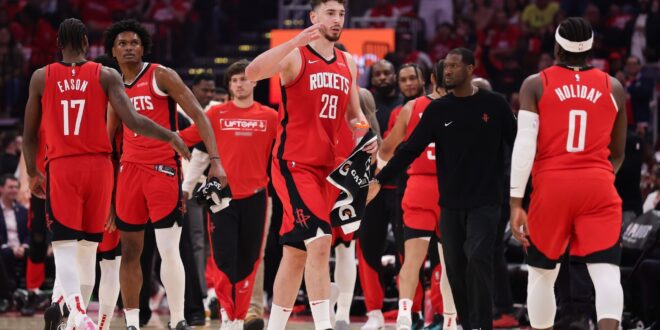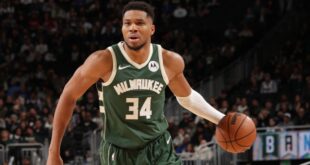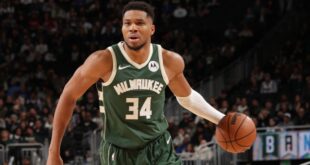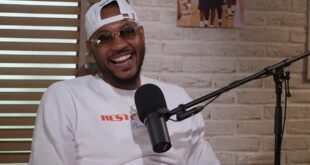**Editor’s Note:** For additional NBA insights, check out more coverage from The Athletic. The opinions expressed here do not necessarily represent those of the NBA or its franchises.
* * *
With Kevin Durant’s addition earlier this summer, the Houston Rockets have emerged as one of the most captivating teams in the NBA.
As training camp draws near, Houston is in the midst of integrating one of the all-time great scorers into a promising young roster that achieved 52 wins last season in a fiercely competitive Western Conference.
The ambitions for a championship have returned to Houston, but the journey to the pinnacle is fraught with hurdles as the team adapts to a new identity.
Here are some critical questions that the Rockets must address as they gear up for the upcoming season.
Although Jalen Green and Dillon Brooks were key contributors to Houston’s success, earning the No. 2 seed in the West last season, parting ways with them was a straightforward choice given the caliber of Durant. This choice became more evident following Green’s struggles during the first-round series against the Golden State Warriors, highlighting the need for a dependable scorer in crucial late-game situations.
Durant possesses the skill set to fulfill that necessity. His experiences with the Golden State Warriors, Brooklyn Nets, and Phoenix Suns demonstrate his remarkable adaptability and efficiency as a high-level scorer in various contexts.
However, bringing Durant in means Houston will need to be more deliberate in their half-court execution and not rely excessively on their speed and athleticism. This adjustment may help the Rockets once the playoffs commence, though they may face challenges during the transition.
One of the primary challenges for Coach Ime Udoka will be to consistently create lineups that effectively space the floor around both Durant and All-Star center Alperen Şengün. Key contributors such as Amen Thompson, Tari Eason, and Steven Adams play essential roles in Houston’s championship aspirations, but how will they respond when pressured to elevate their offensive game? Will players like Fred VanVleet, Dorian Finney-Smith, and Reed Sheppard step up due to their shooting skills?
Udoka must carefully balance capitalizing on the physical advantages his team can harness while ensuring that the lineups generate effective offense.
Although this issue hasn’t fully surfaced yet, expectations are that Durant will soon sign an extension that will secure his future with Houston. As of Wednesday, however, the 36-year-old has only one year remaining on his current contract, worth about $54.7 million.
Many in the league believe Houston is also trying to finalize a long-term extension with Eason, who has one year left on his deal, before finalizing Durant’s new contract. The hope is that securing both players will clarify the financial landscape for the Rockets moving forward.
At this point, the discussion around Durant’s contract isn’t a matter of whether he will stay in Houston, but rather when — and for how long?
Durant celebrates his 37th birthday on September 29, and while he continues to perform at an All-Star level after 18 seasons, it’s understandable if he seeks stability in the final chapter of his career. He may also want to keep his options open for a potential last championship run elsewhere. As always with Durant, his future remains uncertain.
Nonetheless, the Rockets will work diligently to keep Durant from entering unrestricted free agency next summer. The appeal of the Rockets-Durant partnership lies in Houston’s immediate readiness to compete at the highest level while also retaining enough young talent to remain a formidable threat in the future as those players develop. The main question is how integral Durant will be to that future.
Recent years have seen teams that acquired superstar talent through trades suffer losses in overall depth, often needing to part with key assets. Typically, the price for a star acquisition is youth and depth.
However, Houston successfully secured the Durant trade while largely preserving its young talent and maintaining necessary depth throughout the roster.
They kept nearly all their recent first-round draftees—except for Green—while also opening sufficient cap space to bring in dependable role players. Many anticipated that prospects like Sheppard, Eason, Jabari Smith Jr., or even Şengün would be involved in the trade for Durant. Yet, Houston retained them all, including Cam Whitmore, who was subsequently traded to the Washington Wizards for a couple of second-round picks.
While Udoka will undoubtedly be pleased to have such talent at his disposal, managing minutes among so many players capable of significant contributions on a strong team will be challenging. Difficult decisions lie ahead concerning every position group that Udoka assembles.
Even though the guard position may be more straightforward to arrange, quality players like VanVleet, Sheppard, and Aaron Holiday will all warrant playing time. There will also likely be heightened expectations for Sheppard after being selected third overall in the 2024 NBA Draft and having a limited role in his rookie season.
The center position promises to be crowded with Şengün and Adams returning, along with veteran Clint Capela, who signed a three-year, $21.5 million deal last summer. Last season, Şengün and Adams accounted for the majority of center minutes, but Capela’s contract suggests he won’t be spending the entire season on the bench.
Finney-Smith’s situation mirrors this, as he joined the talented group of Houston wings—alongside Durant, Thompson, Eason, and Smith—after signing a four-year, $53 million contract this summer.
It’s hard to envision a scenario where Udoka fields multiple configurations featuring three point guards, three centers, and six wing players. He will need to determine who fits best within the system… or Houston might become a strong candidate to pursue a consolidation trade to strengthen their top rotation with another big name.
While the Rockets’ lack of experience and struggles to execute in critical moments were glaring in their playoff exit against the Warriors last year, Udoka introduced an intriguing dimension.
After testing a double-big lineup with Şengün and Adams in limited situations during the regular season, Houston fully embraced this strategy against the smaller Warriors, dominating the boards during the (mostly) competitive seven-game series.
In that series, Şengün and Adams shared the court for 93 minutes, outscoring the Warriors by 32 points during their time together. Their combined size and strength posed ongoing problems for Golden State’s smaller lineup, and Adams’ presence allowed Şengün to function more effectively as a perimeter creator when the pace of the game slowed.
Is this a one-off success, or could it signal a broader approach for Houston moving into the new season? How does Capela fit into these double-big combinations? Would it alter Durant’s role if he plays alongside two bigs for extended stretches? How will Thompson fare in pairings with two towering players? What if it becomes clear that Şengün thrives more as a power forward?
Houston has made significant strides in forging its tough identity under Udoka last season. Even with the return of many familiar faces, it seems the Rockets still have considerable work to do to refine their identity and determine the best strategies for when the playoffs arrive.
***
Will Guillory is an associated writer for The Athletic, reporting on the New Orleans Pelicans. Prior to joining The Athletic, he worked at The Times-Picayune/NOLA Media Group, covering the Pelicans since 2016. A native of New Orleans, you can follow William on Twitter @WillGuillory.
 NBA News NBA News, Match Reports and Updates
NBA News NBA News, Match Reports and Updates



